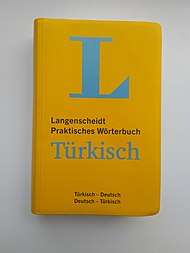Langenscheidt
Langenscheidt (German pronunciation: [ˈlaŋənʃaɪ̯t])[2][3] is a privately held German publishing company, specialising in language reference works. In addition to publishing monolingual dictionaries, Langenscheidt also publishes bilingual dictionaries and travel phrase-books.
 | |
| Founder | Gustav Langenscheidt |
|---|---|
| Country of origin | Germany |
| Headquarters location | Berlin, Germany (formerly Prussia) since 1 October 1856 |
| Distribution | Worldwide |
| Publication types | Dictionaries; Maps; Atlases Travel Products |
| Nonfiction topics | Language references Travel guides |
| Revenue | € 131 million (2010)[1] |
| Official website | langenscheidt |
Langenscheidt has language-to-language dictionaries in many languages, including: English, French, Spanish, Italian, Dutch, Swedish, Greek, Ancient Greek, Latin, Arabic, Chinese and Croatian, and in varying sizes, ranging from small travel pocket dictionaries to large desk sized ones.
History
The Langenscheidt Publishing Group was founded on 1 October 1856 by Gustav Langenscheidt, in response to other publishers' refusal to publish self-study materials developed by him for learning French, which he subsequently published under the title Unterrichtsbriefe zur Erlernung der französischen Sprache ("Teaching letters for learning the French language"). These learning materials became very popular and were widely read, so today Langenscheidt can be considered the "Father of distance education". From 1867 Langenscheidt Publishing Group had its own printing press.
From 1869 Langenscheidt worked with Karl Sachs and Césaire Villatte on the Encyklopädisches französisch-deutsches und deutsch-französisches Wörterbuch ("Encyclopedic French-German and German-French dictionary") and published it in 1880. In 1874, Langenscheidt was awarded the title of professor.
In 1891, in close collaboration with Eduard Muret and Daniel Sanders, he started working on the English equivalent, the Encyklopädisches englisch-deutsches und deutsch-englisches Wörterbuch ("Encyclopedic English-German and German-English dictionary"). Langenscheidt did not live to see its publication; his son Carl, his successor, published it in 1901.
Dictionary structure

The structure for most Langenscheidt dictionaries is the same. Most pocket dictionaries include around 55,000 references designed for tourists or people studying beginning or intermediate foreign languages, while larger desk sized interlanguage dictionaries include around 220,000 references.[4] After the two languages' references conclude, grammatical assistance appears in the Appendix section, including helpful abbreviations, geographical regions, currency values, temperature conversions, and numerical values.
References
- 2010 sechs Millionen Euro weniger Umsatz
- Dudenredaktion; Kleiner, Stefan; Knöbl, Ralf (2015) [First published 1962]. Das Aussprachewörterbuch [The Pronunciation Dictionary] (in German) (7th ed.). Berlin: Dudenverlag. p. 543. ISBN 978-3-411-04067-4.
- Krech, Eva-Maria; Stock, Eberhard; Hirschfeld, Ursula; Anders, Lutz Christian (2009). Deutsches Aussprachewörterbuch [German Pronunciation Dictionary] (in German). Berlin: Walter de Gruyter. p. 688. ISBN 978-3-11-018202-6.
- "German-Swedish dictionary". Langenscheidt. Retrieved 11 August 2016.